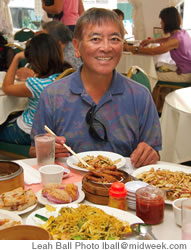Dining On The Hoof
You can put on calories and take them off at the same time by joining Anthony Chang’s walking culinary tour of Chinatown, with a little history on the side

|
Chinatown in Honolulu is like a city within the city. It’s a whole other world that some of us may not have explored yet, thus leaving us unaware of the magic that happens in Chinatown on a daily basis. Luckily, Anthony Chang is around to guide the curious through the vast marketplace of food, culture, history, commerce - and, oh, did I mention food?
Chang leads culinary walking tours of Chinatown once a month on Saturdays, during which he tells jokes and is sure to run into a few friends along the way. He shares his historical knowledge of the area, as well as where to find the best dim sum, rice or wheat noodles, chicken and even bubble tea.
“In my mind you need to understand the history and geography of China to understand its cuisine,” explains Chang.
I, the adventurous foodie/MidWeek reporter, tagged along on the July 14 tour, which turned out to be kind of a private one, with only myself, our photographer and a young man named Alan who said he likes to cook and wanted to take the tour to expand his “cooking horizons.”
Our first stop was on the sidewalk behind Indigo’s Eurasion Cuisine, with the Hawaii Theatre to our left. Chang points out the French wine bar, Du Vin and the Soul de Cuba restaurant, explaining that it’s the first and only Cuban restaurant in Honolulu:
“There are lots of Chinese in Cuba, so it’s very fitting for the district.”
He slides in a bit of history here, explaining that in the late 1700s to early 1800s - when Honolulu Harbor came much further inland than it does today - the bay by Nuuanu became important for commerce, particularly fishing.
“The king at the time,” he continues, “seeing the downtown commerce, moved his residence to the area. The king followed a path to Waikiki, which is now known as King Street.”
Chang leads us to the back entrance of Indigo’s where he pokes his head in, asking to be let in, as they are not open for business yet. Anyone who has patronized Indigo’s has surely noticed the building is made of brick and has probably seen the skinny blue iron doors on the inside walls, both of which are reminiscent of 1800s Chinatown, when brick and iron were common building materials.

|
“In local slang,” he laughs as we walk in through the enormous wooden decorative doors at the back of the restaurant, “this is making house.”
Indigo’s serves Moroccan and French cuisine, Chang says, and offers a daily lunch buffet, as well as a popular martini happy hour on weekdays.
Onward we go, learning along the way about the Grand Cafe Bakery (formerly a cooking shop) and the Chung Sun noodle house, where not a hint of English is spoken, except among we tour participants. Chang grabs a bag of rice noodles from the restaurant’s refrigerator and tells us that the noodle, called lai phan, “is the spaghetti of Chinese rice noodles.”
On Hotel Street, we see Maria Bonita’s, a Mexican place in an otherwise Chinese world, which Chang says “serves a burrito the size of a small purse.”
“This was at one time the largest Chinatown in the country,” he says. “Hawaii’s Chinatown is not exclusively Chinese, it’s always been marked by diversity.
“This is the seediest part of our tour,” he continues, pointing out the old “Hubba Hubba” live nude club/burlesque house, now abandoned above Maria Bonita’s.
“Hubba hubba came from the Chinese phrase ‘how, buhow,’” Chang says, a phrase used by men to ask each other what they thought of women they saw.
The English translation is “good or no good.” Americans could not say the phrase exactly right, so it evolved into “hubba hubba.”
Next we walk by the Mini Garden noodle house, the first Hong Kong noodle house in Honolulu, and also the Little Village Noodle House, where Chang tells us that the husband and wife owners came to Honolulu 10 years ago with $96 and one suitcase. Here, Chang talks about the tsui noodle, one that has an initial resistance to your teeth, but is followed by a burst of succulence. We glimpse inside the kitchen where a cook uses a traditional Chinese wok, which is heavy and made of iron. He vigorously rocks the wok, Chang says, to keep the tastes in.
At noon we walk with grumbling stomachs to Mei Sum Chinese Dim Sum. Chang orders us a plethora of items, so we can get a taste of traditional Chinatown favorites. We eat dim sum, something with deep fried garlic eggplant, pan fried turnip cakes, singapore noodles (thin curried noodles), glutinous rice with chicken and mushroom wrapped in a lotus leaf, fried taro, shrimp dumplings, a plate of thick rice noodles with shredded beef and an egg tart for dessert. Chang also orders us some chicken feet, which by the way are a standard by which dim sum restaurants are judged.
The skin of the foot resembles that of mochiko chicken, and I’d describe it as jiggly and boney. It actually tasted pretty good. Unfortunately there’s just not a lot of meat on a chicken foot, but tasty all the same.
After lunch we explore the tiny but very busy Char Hung Sut, a 60-year-old manapua factory, where customers can see literally right in front of them how this local delight is made and then take home some fresh product. Chang points out a batch of siu mei being made, a standard dumpling of street vendors, he
Page 1 of 2 pages for this story 1 2 >
E-mail this story | Print this page | Comments (0) | Archive | RSS
Most Recent Comment(s):








